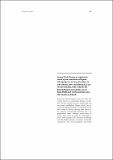Por favor, use este identificador para citar o enlazar a este item:
http://hdl.handle.net/10261/145822COMPARTIR / EXPORTAR:
 SHARE
BASE SHARE
BASE
|
|
| Visualizar otros formatos: MARC | Dublin Core | RDF | ORE | MODS | METS | DIDL | DATACITE | |

| Campo DC | Valor | Lengua/Idioma |
|---|---|---|
| dc.contributor.author | Recuero, Ernesto | - |
| dc.contributor.author | García-París, Mario | - |
| dc.date.accessioned | 2017-02-28T09:29:44Z | - |
| dc.date.available | 2017-02-28T09:29:44Z | - |
| dc.date.issued | 2016-12 | - |
| dc.identifier | e-issn: 1843-5629 | - |
| dc.identifier | issn: 1584-9074 | - |
| dc.identifier.citation | North-Western Journal of Zoology 12(2): 385-389 (2016) | - |
| dc.identifier.uri | http://hdl.handle.net/10261/145822 | - |
| dc.description.abstract | Introduced species represent one of the most concerning factors in conservation biology, as they may become a threat for native biodiversity and ecosystems' equilibrium. Human activity has become a strong dispersal force for organisms of any kind, either by actively releasing alien species or by passively transporting colonizers into new geographical areas. Although introductions of species have been occurring for thousands of years, their frequency has increased accordingly with the higher intensity of modern worldwide commercial and non-commercial movements (Hulme 2009). In the majority of cases, introduced species fail to thrive in the new environments and in fact just a small part eventually become invasive and thus a threat for native biota. However, it is important to keep track on introductions, as often we do not fully understand the processes controlling biological invasions, and even small changes in biotic or abiotic factors can turn already established alien species into invasive (Mack et al. 2000). | - |
| dc.publisher | University of Oradea | - |
| dc.relation.isversionof | Publisher's version | - |
| dc.rights | openAccess | - |
| dc.subject | Introduced | - |
| dc.subject | Mexico | - |
| dc.subject | Australia | - |
| dc.subject | Invasive | - |
| dc.subject | Diplopoda | - |
| dc.title | A new North American region colonized by the Australian millipede Akamptogonus novarae (Humbert & DeSaussure, 1869) (Polydesmida, Paradoxosomatidae), with a key for the known Paradoxosomatidae species from North and Central America and the Caribbean Islands | - |
| dc.type | artículo | - |
| dc.date.updated | 2017-02-28T09:29:45Z | - |
| dc.description.version | Peer Reviewed | - |
| dc.language.rfc3066 | eng | - |
| dc.rights.license | http://creativecommons.org/licenses/by/4.0/ | - |
| dc.relation.csic | Sí | - |
| dc.type.coar | http://purl.org/coar/resource_type/c_6501 | es_ES |
| item.fulltext | With Fulltext | - |
| item.openairecristype | http://purl.org/coar/resource_type/c_18cf | - |
| item.cerifentitytype | Publications | - |
| item.grantfulltext | open | - |
| item.openairetype | artículo | - |
| Aparece en las colecciones: | (MNCN) Artículos | |
Ficheros en este ítem:
| Fichero | Descripción | Tamaño | Formato | |
|---|---|---|---|---|
| NW J Zool 12(2) 385-389 (2016).pdf | 950,74 kB | Adobe PDF |  Visualizar/Abrir |
CORE Recommender
Page view(s)
296
checked on 23-abr-2024
Download(s)
328
checked on 23-abr-2024
Google ScholarTM
Check
Este item está licenciado bajo una Licencia Creative Commons

